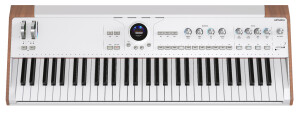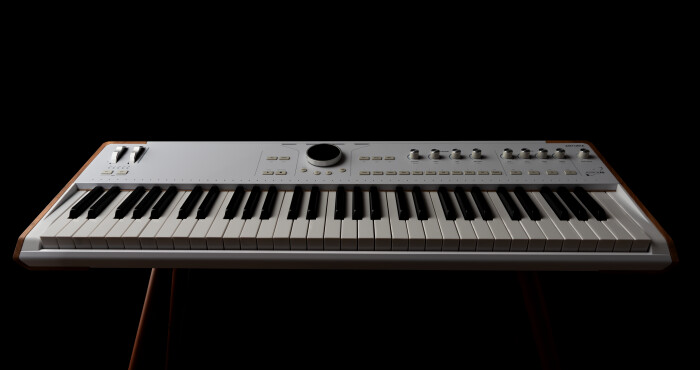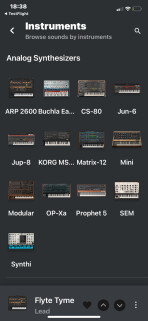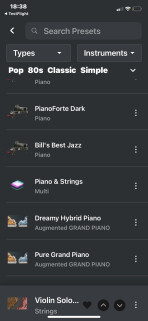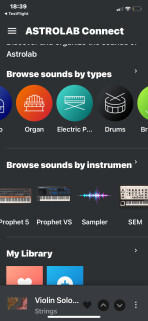Ever since the Brutes and Keysteps affair, Arturia has been known to shake up the market with innovative products offering excellent value for money. And this Astrolab, tackling the stage keyboard market, is not going to tarnish the manufacturer's reputation - quite the contrary...
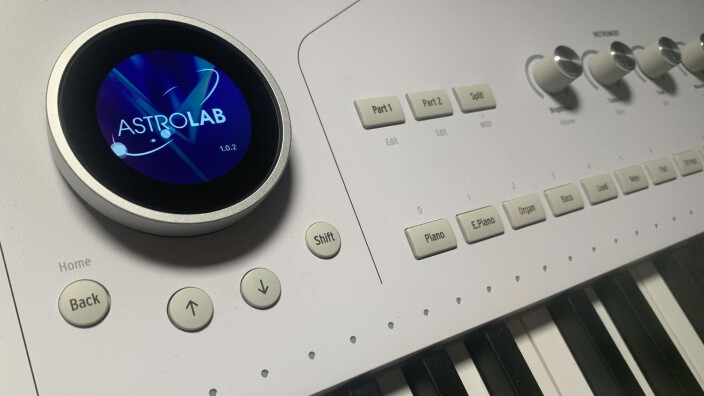
A benchmark brand for almost twenty years in keyboard modeling with its V-Collection, Arturia has also made a name for itself in the world of hardware synthesizers with its Brute range, while offering a set of the most accomplished controllers and interfaces on the computer side. In fact, many of us have been dreaming of a hardware keyboard based on the V-Collection, more ergonomic and accomplished than the Origin released in 2009, and undoubtedly more live-oriented too. And that’s precisely the direction Arturia has taken with the Astrolab, a keyboard based on its famous Analog Lab.
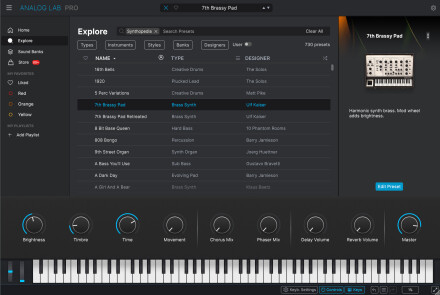
Indeed, it’s clear that Analog Lab’s simplicity reflects a commitment to efficiency that is highly relevant to live performance: a large set of quality sounds for maximum versatility, a few essential parameters to adapt each of them to the performance, the possibility of simply defining playlists such as splits or multis… All that remained was to make a stand-alone keyboard incorporating all this to delight everyone, and if possible not too expensive and innovative, just to put a little movement into the rather static market of stage keyboards and its predominantly red color. That was the brief from Grenoble, and now they’ve delivered their copy on the occasion of Arturia’s 25th anniversary: let’s get on with unwrapping the gift!
The great white with a black knob
The Astrolab impresses right from the box. Apart from the keyboard keys and knobs, it’s made entirely of white metal, flanked by light-colored wood cheeks. This translates into a weight of 9.9 kg on the scale, with dimensions of 935 × 327 × 99 mm, considerably heavier than a Nord electro 6D 61 (8.1 kg), but a little lighter than a Nord Stage Compact 73 with its extra octave at 10.4 kg. In any case, the whole unit looks really good and gives a great impression of clarity: the controls are well spaced out and logically arranged, while the large central knob incorporating a screen gives the keyboard a real identity…
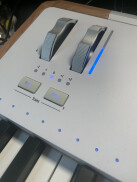
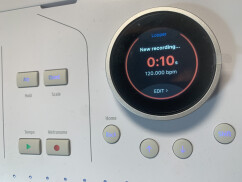
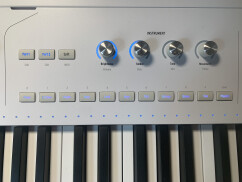
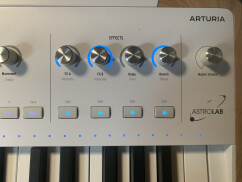
Before moving on to connectors, each control on the keyboard is either backlit or, in the case of encoders, has a luminous ring to indicate its status. Each key on the keyboard is topped by a small luminous marker, which can take on a blue or orange color depending on the split zones…
With or without wires
All Astrolab inputs and outputs are located on the rear panel. From left to right, there’s a MIDI input and output on 5-pin DIN, four pedal inputs (expression, sustain and two auxiliary), two XLR/Jack combo audio inputs with gain potentiometer, a pair of audio outputs and a headphone output, all in 6.35 jack format. On the right-hand side, you’ll find everything to do with computing and power supply: a USB-A socket for powering the keyboard, as well as an external MIDI controller or storage device, a USB-C port for connection to a computer, smartphone or tablet, a DC socket with screw thread for connection to a mains power supply, and a power on/off button.
Last but not least, the keyboard offers Bluetooth and Wi-Fi connectivity: the former lets you stream audio from your computer, smartphone or tablet (but it’s an input, not an output, so you won’t be able to pair your Bluetooth headset, for example), and the latter lets you connect to your computer to control the Analog Lab Pro software, or your smartphone via Astrolab Connect, the navigation app available for both iOS and Android.
Connect yourself…
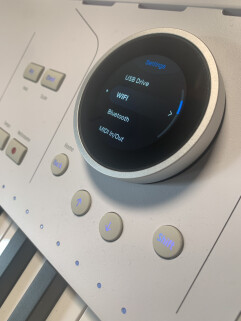
It’s a fact that, while the argument of offering thousands of presets from a single controller is appealing, we have to admit that without an efficient navigation system, this wealth of information can quickly prove counterproductive: the best of thumbwheels shows its limits, where touch, because it allows text search, tag/category navigation and ultra-fast scrolling of long lists simply by scanning the screen, is undoubtedly the most effective solution.
And it’s all the more so because the Astrolab Connect app is ergonomically based on the preset browser that Arturia has been using for several years: you’ll quickly find what you’re looking for, and you’ll have no trouble setting up playlists and keyboard splits. A real pleasure, which we hope will be emulated by the competition…
For those allergic to smartphones, there’s no need to use Astrolab Connect, as the keyboard is perfectly controllable via its physical controls. It’s just a big plus for navigation, which we’ll leave aside and return to the keyboard.
Plug & play
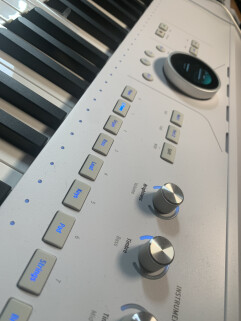
The semi-weighted keyboard is uneventful. Sensitive to aftertouch, it proves precise in use. However, it’s advisable to try it out in-store to make up your own mind, as all tastes are catered for in this respect, as its touch is a little less firm than that of a Komplete Kontrol, and its white keys have a glossy finish while the black ones are matte.
It’s worth noting that there may be a slight delay when switching from one preset to another, which varies according to the complexity of the patch. We’re not talking about a three-second delay, though, and given that it’s a computer lurking in the bowels of the Astrolab to offer 1,300 presets from 34 instruments, it’s easy to understand why, so we won’t hold it against you.
In any case, the keyboard is extremely pleasant to use, all the more so as its software integration is very successful, whether via the Astrolab Connect app or the Analog Lab plugin, which, if you have the V-Collection, gives you access to the complete instrument interfaces on your computer… In short, we’re looking at a resolutely modern, well-thought-out beast that has great potential both in the studio and on stage, with functions such as MIDI Looper, the ability to stream audio via Bluetooth, and so on. The way in which multis and splits (within the limit of two presets) and playlists (divided into songs and presets) are managed finally struck me as extremely clear. A perfect product? As far as we can tell, not far from it, if we fully understand its purpose and the choices made by Arturia…
What Astrolab isn’t…
Having already rolled out its Brute, Key and Freak ranges, Arturia has now entered a new market with Astrolab: that of stage keyboards, quite distinct from synthesizers in that they are not designed for sound research.
So we’re not dealing with a synth in the sense that an Origin or V-Collection Keyboard might have been, which some will regret. Nor are we faced with a Keylab-style computer control keyboard: the purpose is absolutely not to drive your sequencer or plug-ins other than Analog Lab. From my point of view, it’s a good thing Arturia didn’t try to hybridize, because what we’d have gained in functionality, we’d probably have lost in simplicity.
This is a solution designed to provide access to a very large number of sounds in the simplest and most effective way possible in a playing situation: that’s what a stage keyboard is all about. And from this point of view, the Astrolab has nothing to be ashamed of when compared to the leader Clavia, whose Nord Electro 6D 61, sold for 300 euros more, could well be a little out of date when compared to this extremely versatile young white wolf, resolutely modern in its ergonomics, and which really only lacks a set of sliders/pulls that electromechanical organ players will find lacking. The Astrolab does offer a solution, however, via the possibility of connecting an external control surface, which opens up a host of new possibilities in addition to the pedals that can be added…
Having said that, it would no doubt have been smart of the manufacturer to make even greater use of the Astrolab Connect app, which could, in addition to its browser functions, include a really interesting polymorphic controller section. It remains to be seen whether the latter will evolve in this direction… Some might also have preferred the multi-touch screen to be integrated into the keyboard, rather than having to use a smartphone. However, if you know anything about the electronic components market, you’ll understand that such a choice would undoubtedly have pushed up the Astrolab’s price, without Arturia necessarily being able to guarantee screen quality on a par with that found on major brand smartphones or tablets. If you can’t beat them, join them: the adage seems apt here, given that it’s the job of Apple, Samsung and co. to make this kind of controller, and that it seems wise for Arturia to build on this expertise rather than reinvent the wheel only less well…
Personally, I’d have preferred to have the pitch bend and modulation wheels on the left side of the keyboard rather than on top. But then, I’m sure the keyboard would have been longer and heavier, and therefore more expensive too, bearing in mind that the manufacturer seems to have done his utmost to stay under the 10 kg mark. It goes without saying, however, that many keyboardists will be eagerly awaiting a 73– or 88-key heavy-touch model, which, depending on the reception of this Astrolab, should probably be forthcoming if we consider what exists in the Keylab range… And it’s also with this in mind that others will no doubt also want a smaller and inevitably more affordable keyboard: 49 or 37 keys, or even a rack or module version, as the plug&play soundbox argument proves extremely seductive beyond the keyboard itself, whether for stage or studio.
In short, while this Astrolab certainly isn’t for everyone yet, and while it won’t exempt Arturia from offering us a real V-Collection keyboard one day soon, enabling us to really get our hands into the engine (and then, the principle of having an iOS/Android app will again show its relevance for managing heterogeneous interfaces), let’s be sure that it’s already very relevant and opens up many horizons. As for whether it will succeed in beating its red competitor to the punch, let’s just say that beyond its tight price tag, it has many functional arguments to do so, but that one of the most important criteria for judging it remains beyond the scope of this test: Clavia products are known for their robustness, and while the Astrolab’s fine workmanship inspires confidence, it remains to be seen whether it will be as durable and sturdy. In terms of future-proofing, however, it has a strong argument in its favor: at the rate at which Arturia releases new plug-ins, we can expect frequent updates to bring ever more sounds and effects, as well as significant improvements to existing physical models. We’re also expecting the keyboard, currently compatible with V Collection 9 instruments, to integrate those of V Collection 10, including the cool Acid V…
Conclusion
As a fan of the V-Collection and a daily user of Analog Lab, I have to admit I’ve been really seduced by Arturia’s proposal which, without turning its back on MAO (integration with the Analog Lab plug-in is obviously perfect, and the Astrolab Connect app oh so relevant), makes us forget the virtual origins of its keyboard in favor of a truly convincing “hardware” experience. Switch on, play, and enjoy the richness of Arturia’s modelling in complete simplicity: without going back on the quality and versatility of the V-Collection’s sound, the keyboard’s intuitive side is indeed the greatest achievement of Arturia’s new baby. As a result, although we know it was designed for the stage, we have little doubt that it should find a place in more than one studio, where its simple access to a myriad of sounds should seduce more than one musician, for a price of 1,600 euros that remains well thought-out… Congratulations to the Grenoble-based company, who are celebrating their 25th anniversary in style, and we can’t wait to see what’s next…


